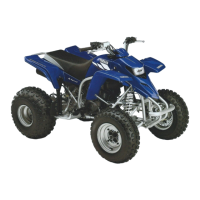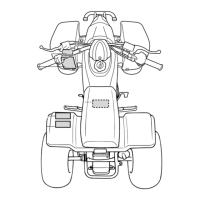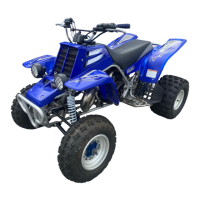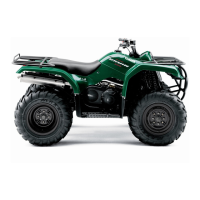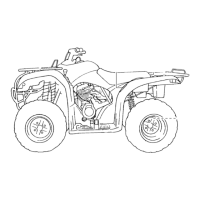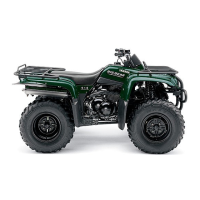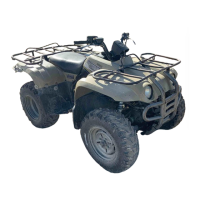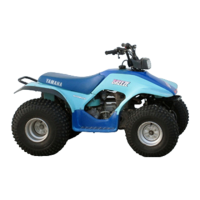Do you have a question about the Yamaha BLASTER YFS200P and is the answer not in the manual?
Key safety instructions and recommendations for ATV operation and rider conduct.
Explains the meaning of warning, caution, and note symbols used throughout the manual.
Illustrates and describes various warning labels on the ATV for safety.
Details the inherent dangers of ATVs and essential safety precautions for operation.
Provides critical safety guidelines for handling gasoline to prevent fires and injuries.
Warns about the dangers of exhaust fumes in enclosed spaces and the need for ventilation.
Identifies key parts of the ATV using numbered diagrams for reference.
Explains how to find and record identification numbers for parts and security.
Describes the function of the main switch and the oil level warning light.
Details the operation of the engine stop and light switches on the handlebars.
Explains the operation of the throttle, front/rear brakes, clutch, and parking brake.
Covers the operation of the shift pedal, kick starter, and starter (choke).
Guides on adjusting front and rear shock absorber spring preload for different conditions.
Outlines checks for brake lever, pedal operation, and brake pad wear.
Details checks for fuel type, capacity, and engine/transmission oil levels.
Covers tire condition, approved types, pressure, and wear limits.
Step-by-step instructions for starting the engine under different temperature conditions.
Explains the shifting process, acceleration, and proper clutch use.
Guides on slowing down, braking, and the initial engine break-in period.
Instructions for parking the ATV, including on slopes, and guidelines for loading accessories.
Emphasizes familiarization with controls and safety information before riding.
Covers safe riding practices, hazard awareness, and the importance of training.
Stresses the necessity of wearing approved helmets, eye protection, and protective clothing.
Details techniques for safely turning and climbing hills, including weight transfer.
Provides guidance on riding downhill, crossing slopes, shallow water, and rough terrain.
Explains how to handle sliding/skidding and what to do if the ATV encounters issues.
Recommends carrying the owner's manual and tool kit for maintenance.
A comprehensive schedule detailing required maintenance tasks at various intervals.
Procedures for checking and replacing engine and transmission oil.
Instructions for cleaning the air filter and spark arrester for optimal performance.
Details on adjusting carburetor settings and setting the idle speed for different conditions.
Procedures for inspecting brake shoes/pads and adjusting brake levers and parking brake.
Covers drive chain slack checks, adjustments, cleaning, and lubrication.
Guides on lubricating control cables, suspension pivots, and steering shaft.
Instructions for removing/installing wheels and replacing headlight/tail lights.
Step-by-step guide for cleaning the ATV to maintain appearance and performance.
Essential steps for preparing the ATV for storage to prevent deterioration.
Lists physical dimensions, engine type, displacement, and bore/stroke.
Details recommended oils, fuel type, tank capacity, and air filter type.
Provides details on frame type, tires, brakes, suspension, and shock absorbers.
A logbook to track scheduled maintenance intervals, dates, and service details.
Outlines the terms of the limited warranty, coverage duration, and exclusions.
Details the advantages and options for Yamaha's extended service plans.
Key safety instructions and recommendations for ATV operation and rider conduct.
Explains the meaning of warning, caution, and note symbols used throughout the manual.
Illustrates and describes various warning labels on the ATV for safety.
Details the inherent dangers of ATVs and essential safety precautions for operation.
Provides critical safety guidelines for handling gasoline to prevent fires and injuries.
Warns about the dangers of exhaust fumes in enclosed spaces and the need for ventilation.
Identifies key parts of the ATV using numbered diagrams for reference.
Explains how to find and record identification numbers for parts and security.
Describes the function of the main switch and the oil level warning light.
Details the operation of the engine stop and light switches on the handlebars.
Explains the operation of the throttle, front/rear brakes, clutch, and parking brake.
Covers the operation of the shift pedal, kick starter, and starter (choke).
Guides on adjusting front and rear shock absorber spring preload for different conditions.
Outlines checks for brake lever, pedal operation, and brake pad wear.
Details checks for fuel type, capacity, and engine/transmission oil levels.
Covers tire condition, approved types, pressure, and wear limits.
Step-by-step instructions for starting the engine under different temperature conditions.
Explains the shifting process, acceleration, and proper clutch use.
Guides on slowing down, braking, and the initial engine break-in period.
Instructions for parking the ATV, including on slopes, and guidelines for loading accessories.
Emphasizes familiarization with controls and safety information before riding.
Covers safe riding practices, hazard awareness, and the importance of training.
Stresses the necessity of wearing approved helmets, eye protection, and protective clothing.
Details techniques for safely turning and climbing hills, including weight transfer.
Provides guidance on riding downhill, crossing slopes, shallow water, and rough terrain.
Explains how to handle sliding/skidding and what to do if the ATV encounters issues.
Recommends carrying the owner's manual and tool kit for maintenance.
A comprehensive schedule detailing required maintenance tasks at various intervals.
Procedures for checking and replacing engine and transmission oil.
Instructions for cleaning the air filter and spark arrester for optimal performance.
Details on adjusting carburetor settings and setting the idle speed for different conditions.
Procedures for inspecting brake shoes/pads and adjusting brake levers and parking brake.
Covers drive chain slack checks, adjustments, cleaning, and lubrication.
Guides on lubricating control cables, suspension pivots, and steering shaft.
Instructions for removing/installing wheels and replacing headlight/tail lights.
Step-by-step guide for cleaning the ATV to maintain appearance and performance.
Essential steps for preparing the ATV for storage to prevent deterioration.
Lists physical dimensions, engine type, displacement, and bore/stroke.
Details recommended oils, fuel type, tank capacity, and air filter type.
Provides details on frame type, tires, brakes, suspension, and shock absorbers.
A logbook to track scheduled maintenance intervals, dates, and service details.
Outlines the terms of the limited warranty, coverage duration, and exclusions.
Details the advantages and options for Yamaha's extended service plans.
| Brand | Yamaha |
|---|---|
| Model | BLASTER YFS200P |
| Category | Offroad Vehicle |
| Language | English |

